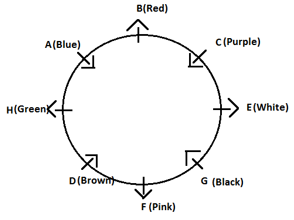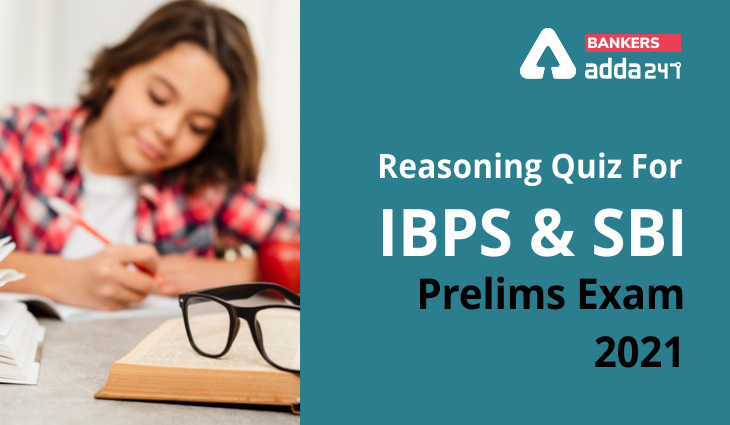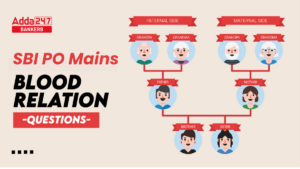Table of Contents
Directions (1-5): Study the following information carefully and answer the given questions.
A, B, C, D, E, F, G and H are sitting around a circular table in such a way that no two persons sitting together face same direction. Each of them likes a different colours, viz Blue, Black, Red, Brown, Purple, Green, White and Pink. (None of the information given in necessarily in the same order.)
C sits third to the left of the one who likes Pink. The one who likes Pink faces outside. Only two persons sit between C and H. The one who likes Blue sits on the immediate right of H. The one who likes Purple sits second to the right of G. G is neither an immediate neighbour of H nor of C. G does not like Pink. Only one person sits between A and the one who likes Purple. D sits on the immediate left of the one who likes Green. G does not like Green. E likes White. E is not an immediate neighbour of A. The one who likes Black is an immediate neighbour of E. The one who likes Brown is an immediate neighbour of F.
Q1. Who amongst the following sits opposite the one who likes Blue?
(a) The one who likes Black
(b) D
(c) A
(d) The one who likes Red
(e) The one who likes Brown
Q2. Who among the following represent the immediate neighbours of the one who likes Purple?
(a) B, F
(b) B, E
(c) C, E
(d) D, F
(e) F, H
Q3. Who among the following sits exactly between H and B?
(a) C
(b) The one who likes White
(c) A
(d) F
(e) The one who likes Red
Q4. Which of the following is true regarding B?
(a) B is one of the immediate neighbours of D.
(b) The one who likes Pink is an immediate neighbour of B.
(c) B sits second to the left of H.
(d) B is an immediate neighbour of the one who likes Blue.
(e) B likes White.
Q5. What is the position of the one who likes Green colour with respect to G?
(a) Second to the left
(b) Third to the right
(c) Fourth to the left
(d) Second to the right
(e) Third to the left
Directions (6-10): In these questions, relationship between different elements is shown in the statements. These statements are followed by two conclusions.
Mark answer as
(a) If only conclusion I follows.
(b) If only conclusion II follows.
(c) If either conclusion I or II follows.
(d) If neither conclusion I nor II follows.
(e) If both conclusions I and II follow.
Q6. Statements: P < R > T = S, V > R >U
Conclusions: I. S < V II. S < U
Q7. Statements: C > F, D ≥ C < M < O = T
Conclusions: I. F < O II. F < D
Q8. Statements: R > W > C > K = N, W = X > A
Conclusions: I. A < K II. A ≥ N
Q9. Statements: E < G > F, J < G ≥ S
Conclusions: I. E > J II. S ≤ E
Q10. Statements: P ≥ A < M = C > L > N
Conclusions: I. P > M II. N < M
Directions (11-15): Study the following information to answer the given questions
In a certain code
‘crown queen story palace’ is written as ‘op lp we jk’,
‘rose queen story flower’ is written as ‘ir lp fu op’.
‘palace king rose water’ is written as ‘ty ir gb jk’
‘story land king dream’ is written as ‘ty xz lo lp’
Q11. Which of the following words can be coded as ‘op fu gb ta’?
(a) crown flower rose water
(b) land water flower princess
(c) flower dream story king
(d) queen flower water lily
(e) palace water land rose
Q12. Which of the following is the code for ‘palace’?
(a) lo
(b) jk
(c) ty
(d) we
(e) fu
Q13. How is ‘flower story crown’ be written in this code?
(a) ty ir fu
(b) lp op we
(c) fu lp we
(d) we fu jk
(e) None of these
Q14. Which of the following code represent for ‘dream’?
(a) xz
(b) lr
(c) fu
(d) Either (a) or (e)
(e) lo
Q15. What does “ty” represent in the code?
(a) King
(b) Crown
(c) Story
(d) flower
(e) water
Practice More Questions of Reasoning for Competitive Exams:
Reasoning for Competitive Exams |
Reasoning Ability Quiz For SBI, IBPS Prelims 2021- 3rd April |
Reasoning Ability Quiz For SBI, IBPS Prelims 2021- 4th April |
Study Plan for IBPS and SBI Exams 2021 |
Solutions
Solution (1-5):
Sol.

S1. Ans (a)
S2. Ans (b)
S3. Ans (c)
S4. Ans (d)
S5. Ans (e)
S6. Ans.(a)
Sol. I. S < V (True) II. S < U (False)
S7. Ans.(e)
Sol. I. F < O (True) II. F < D (True)
S8. Ans.(c)
Sol. I. A < K (False) II. A ≥ N (False)
S9. Ans.(d)
Sol. I. E > J (False) II. S ≤ E (False)
S10. Ans.(b)
Sol. I. P > M (False) II. N < M (True)
Solution (11-15):
Sol.

S11. Ans.(d)
S12. Ans.(b)
S13. Ans.(c)
S14. Ans.(d)
S15. Ans.(a)
Practice with Online Test Series for SBI and IBPS Prelims 2021:
Click Here to Register for Bank Exams 2020 Preparation Material




 GA Capsule for SBI Clerk Mains 2025, Dow...
GA Capsule for SBI Clerk Mains 2025, Dow...
 The Hindu Review October 2022: Download ...
The Hindu Review October 2022: Download ...
 Important Blood Relation Questions for S...
Important Blood Relation Questions for S...





